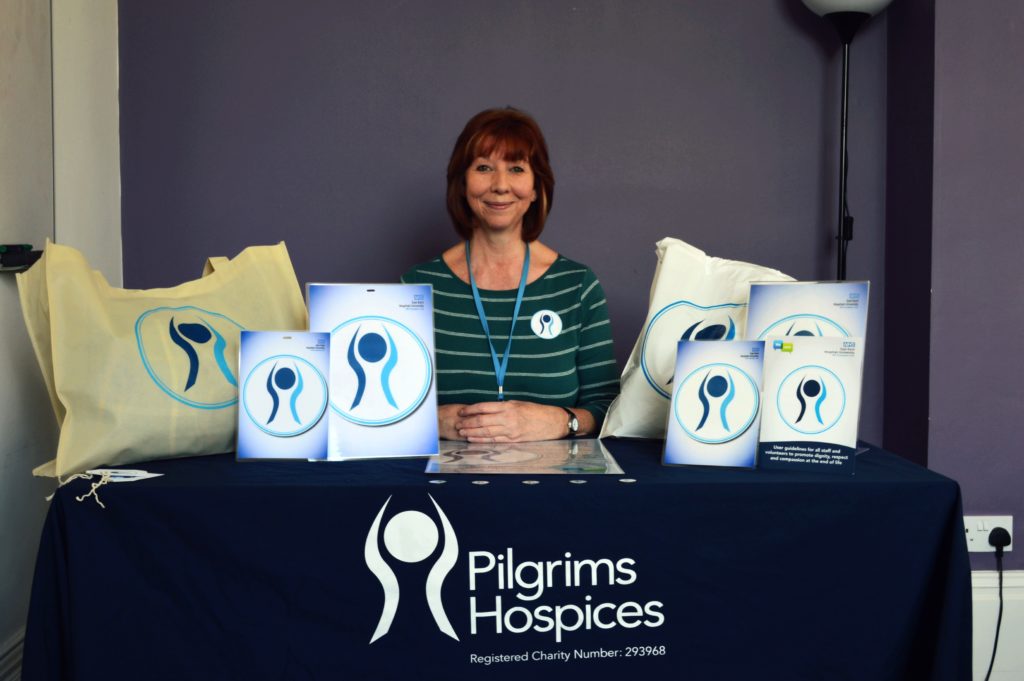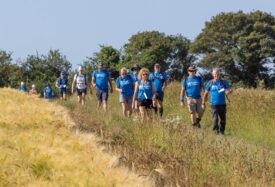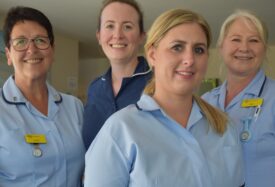A compassionate approach to end-of-life care

East Kent Hospitals has formed a partnership with Pilgrims Hospices that’s improving end-of-life care across the Trust’s hospital sites.
Known as the Compassion Project, the initiative promotes dignity, respect and compassion at the end of life – represented by a Compassion symbol in the form of the Pilgrims Hospices logo.
Consultant nurse for palliative care and East Kent Hospitals’ end-of-life clinical lead, Sue Cook, said: “For understandable reasons, end-of-life care is a topic that many people shy away from. But caring for people until the end of their lives is integral to the values of the NHS and all it stands for.
“Those of us who work in the NHS have a duty to ensure that our patients are cared for with dignity, respect and compassion until they die.
“That’s why the Compassion Project – and its symbol – is so important to us and all who help those approaching the end of their lives.”
Wendy Hills, Pilgrims Hospices Director of Nursing and Care, said: “Pilgrims has over 30 years of experience working with families at some of the most difficult times of life. We are committed to having a positive impact on the individual’s experience of end of life care for as many people in east Kent as possible. This project came from that desire.”
The project was funded thanks to a legacy donation from the family of Pat Morley, a past Kent and Canterbury Senior Matron and Pilgrims trustee. Pat worked tirelessly to promote excellent nursing within the profession she loved. She also volunteered for many years as a Trustee of Pilgrims Hospices, where her experience was invaluable.
Pilgrims has over 30 years of experience working with families at some of the most difficult times of life. We are committed to having a positive impact on the individual’s experience of end of life care for as many people in east Kent as possible. This project came from that desire.
Wendy Hills, Pilgrims Hospices Director of Nursing and Care
Wendy added: “Together with EKHUFT, we are delighted with the success of the Compassion Project throughout east Kent’s hospital wards so we can support as many people as possible to live well until the very last moment of their life.”
The Compassion symbol is displayed on wards when a person is expected to die within the next few hours or days – or when a person has just died. Its display is to encourage an atmosphere of quiet and respect at this significant time.
On seeing the symbol, visitors to a ward are asked to be considerate in their behaviour and activity, including restricting the use of mobile phones. Visitors are also asked to be sensitive when encountering people who are grieving or distressed.
Following a conversation with the patient and/or their family, the Compassion symbol is shown at ward stations, on ward boards and on bedside curtains.
The symbol is also used after the patient has died. Relatives are given their loved one’s property in a branded Compassion bag to ensure continued support and sensitivity.
Since its launch in June 2017 the Compassion Project has been rolled out on 9 wards across the Trust initially, and has gradually been cascaded to over 880 staff in more than 50 clinical wards and departments where patients who are dying, and their families, are being cared for.
How a loved one dies can have a profound and long-lasting impact on those who are left behind. Therefore it’s essential that staff and visitors are sensitive to the needs of the person who is dying, and their loved ones, at all times.
Annie Hogben, Education Project Lead for Pilgrims Hospices
All staff, those in clinical and other roles, who come into contact with patients and families at this incredibly difficult time are being given training in the use of the Compassion symbol and are being encouraged to ensure it becomes part of the normal ward routine and culture when caring for patients and their families.
Education Project Lead for Pilgrims Hospices, Annie Hogben, said: “How a loved one dies can have a profound and long-lasting impact on those who are left behind. Therefore it’s essential that staff and visitors are sensitive to the needs of the person who is dying, and their loved ones, at all times.

“The Compassion Project and its symbol represent a patient-focused and relative-focused approach to end-of-life care. This acknowledges clinical reality, but also ensures that we never neglect dignity, compassion and emotional needs. The collaborative working over these past months has been very rewarding for everyone taking part. Staff at the Trust have really embraced the project, using their own ideas and creativity to help make this a success. Ultimately, thanks to everyone’s commitment we have made a huge difference for patients and their families.
Posters have been displayed throughout the hospital wards and departments to let the public know more about the project and the use of the symbol.
“This small, unassuming sign made a big difference”
Andrea Reid, who lives in Folkestone, Kent gained first-hand experience of the positive impact of the Compassion symbol when her aunt was cared for in an East Kent hospital.
“The care and compassion shown to my aunt and her family when she was being cared for in hospital was clearly evident from the moment that I first visited, took a seat and held her hand. Once my family had all arrived and those difficult but sensitive discussions had taken place, a bed in a side room was found so we could visit and stay the night without worrying about disturbing the other patients on the ward.
We were able to take up the space within the room without feeling that we were in the way, talk freely, laugh together and have quiet moments of reflection, all in the knowledge that the staff were there if we needed them but without unnecessary intrusion – quality time that we were really able to make the most of.
Andrea, who experienced the Compassion Project first-hand
“The Compassion symbol appeared at the doorway. This small, unassuming sign was making a big difference to those approaching the room.
“Despite being near the ward entrance, there didn’t seem to be much general disturbance, as staff from porters to doctors went quietly about their daily business. The nursing staff all hesitated at the door, explained why they needed to come in and gave us time to either leave the room or move out of the way with a calm, unhurried air. The cleaners ensured that the room was kept hygienic and pleasant without being intrusive. At one point the consultant reviewed my aunt from the doorway as there was no need for any hands-on intervention at that time, and so with quiet respect and a gentle nod he checked that all was well and moved on.
“The difference that this made to us all, my aunt included, was only really evident on reflection afterwards. Such was the discretion and respect afforded to us that the care and general day to day business of the ward almost faded into the background as we sat and chatted about old times and even celebrated my aunt’s 80th birthday the day before she died. We were able to take up the space within the room without feeling that we were in the way, talk freely, laugh together and have quiet moments of reflection, all in the knowledge that the staff were there if we needed them but without unnecessary intrusion – quality time that we were really able to make the most of.
“I think that our hospital staff are often working in a pressured and high-speed environment, but the small and unassuming Compassion symbol is just enough to trigger a pause and a moment’s consideration for those dealing with the worst news possible, and to give staff the permission not to intrude on those valuable last moments unnecessarily, but to be discreetly available as the need arises. My impression was that this was embraced by staff at all levels.”


